Apple’s Vision Pro mixed reality headset went on sale in the UK this week, following a US launch earlier in the year. This is Apple’s biggest new brand stretch attempt since the Apple Watch in 2015, so it has been hotly anticipated. “There’s a world that exists after the iPhone, and this is the beginning of that moment for Apple,” gushed Ian Hamilton, editor of Upload VR (1). However, questions have been raised over the hefty price tag and consumer interest in the device.
In this post I analyse the Apple Vision Pro launch and make an early attempt to answer the question: brand stretch hit or miss? We recommend assessing any brand stretch on two key dimensions. The first dimension, Ability to Win, is the one where many brand stretch attempts actually fail. However, in this case I expect Apple has the capability and expertise to both make the Vision Pro and then get it to market, given the strength of the Apple ‘ecosystem’. Therefore, this post will focus on the second dimension, Size of Prize, by looking at i. market size and growth, ii. consumer relevance, iii. value proposition, iv. competitive intensity and v. results to date.
1. The market has stalled, not taken off
Virtual reality (VR) headsets have been talked about for many years. They are often used to visualise the elusive concept of the “metaverse”. Meta’s Mark Zuckerberg has predicted that this immersive, virtual world will be the successor to the mobile web (1). However, so far, the hype has failed to translate into sales. Take IDC’s market forecast made back in 2021, for example. This predicted global VR headset shipments would double from c.10million in 2021 to 20 million+ in 2023 (2). However, actual 2023 shipments were only c.8million (see red lines below) and IDC’s updated forecast for 2026 of 6 million units is a fraction of what they originally forecast. And even this estimate looks optimistic, given first quarter shipments in 2024 down a whopping 67% versus year ago, despite the launch of Apple’s Vision Pro.
The leading brand is Meta’s Quest, with 20 million headsets sold since buying Oculus in 2014. To put that into perspective, this is less than half the number of Apple Watches sold per year (50 million), for a product with a similar or even more expensive price point.
Market Size and Growth Score: 3/10
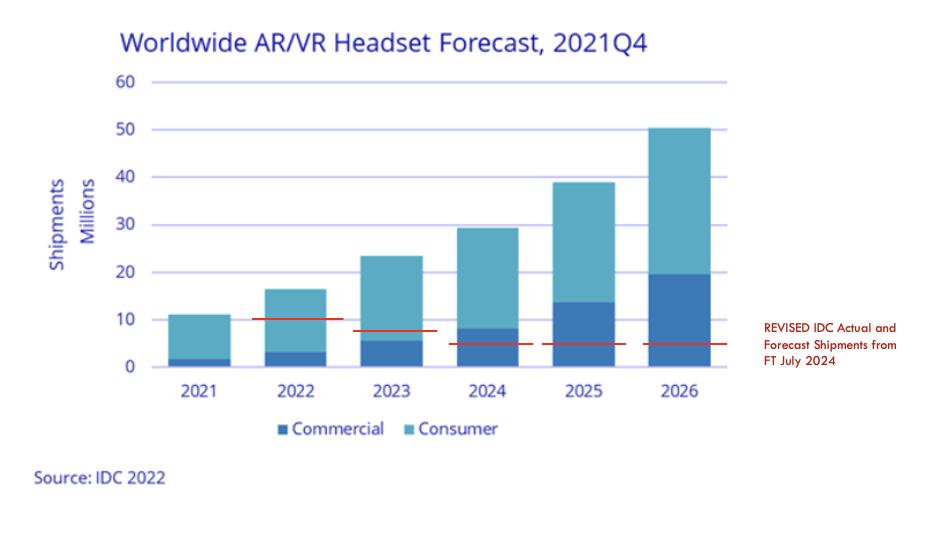
2. Limited consumer relevance
So, why have VR headset sales failed to take off so far? I did my own research back in 2022, buying a Meta Quest headset and exploring Meta’s virtual Horizon World. My experience mirrored that reported in a Times article: “A flurry of initial use followed by the device being thrown into a drawer, never to be touched again.” The device was pretty uncomfortable to wear. And after an hour or so of use I had a headache. Horizon World itself was very disappointing, to say the least. The visuals were naive and child-like, as shown by the virtual meeting room I tried out (see below). The places I visited, such as virtual concerts and sports events, were populated by only a handful of legless avatars (Meta was unable to give avatars legs, despite billions of dollars of R&D).
It just feels that the added value of the consumer experience is not worth the extra hassle, inconvenience and cost. There is still a huge demand for “real reality”, as I posted on here. This is shown by the massive success of Taylor Swift’s global Eras tour, estimated to gross $5.7 billion for the star (3). And if you can’t make a live event in person, smart TVs and home cinema systems create an immersive, multitude-media experience.
Time will tell if Apple’s approach of “spatial computing” will be a game-changer that dramatically increases consumer relevance. Personally, I’m not sure it will.
Consumer relevance Score: 5/10
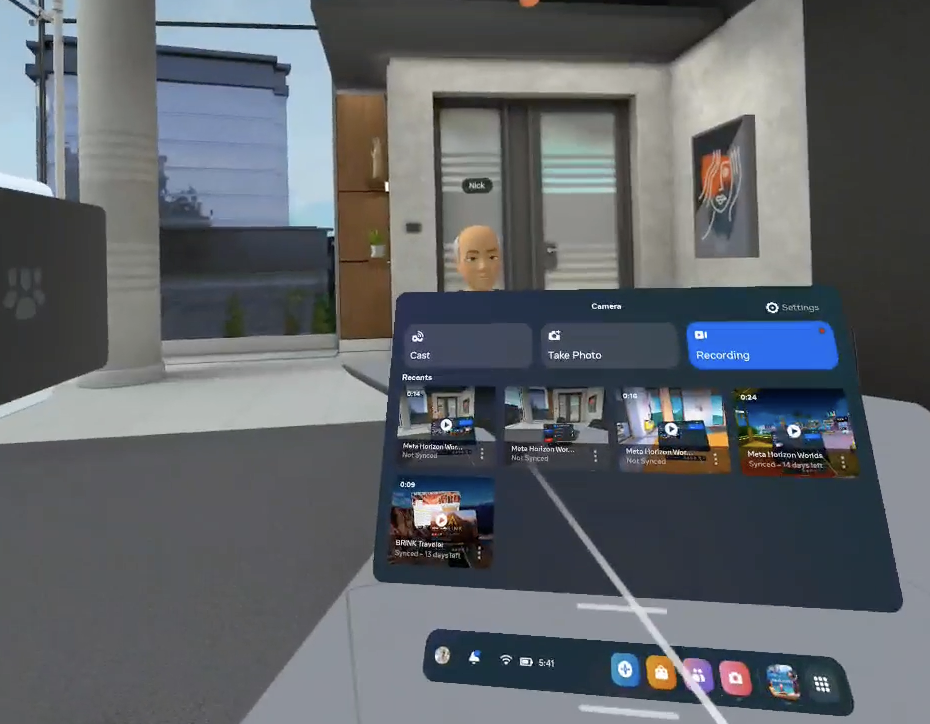
3. Value proposition
So, what about the value proposition of the Vision Pro itself? On the price side of value equation, the new product is eye wateringly expensive at £3,500, 10x the price of the Meta Quest 3 headset. Premium pricing has been a key part of Apple’s strategy to date, but the price premium has been nothing like as big. The iPhone is c. two to three times the price of an Android phone, for example, according to a survey quoted in the Washington Post (4).
With a 1,000% price premium, the Vision Pro would need to be a truly amazing, transformative product. Here, hands up, I have not tried the product myself. I class myself as an “Appleaholic”, but even for me the price tag is too high. However, I was able to dig up some insight from reports on the product so far:
- Lack of apps to use with the device: this is a key negative. “Apple said recently that there were ‘more than 2,000’ apps developed for the device, five months after its US debut,” reports the FT. However, this compares with 20,000+ apps created for the iPad a few months after it’s launch.
- Functional difference versus Meta Quest headset: you can shift between virtual reality, where you’re fully immersed in a digital world, and “augmented reality”, where images are overlaid on the real surroundings. You can see this in action in one of the launch ads below. The guy on the right can see apps appear in front of his eyes (middle right) while he can also see real life behind these, so able to kick a football back to his daughter (bottom right).
Net, it is not obvious that the consumer experience offered by Apple’s Vision Pro justifies the price premium. Nor that is has enough added value versus other VR headsets to really create a step-change in consumer take-up.
Value proposition Score: 3/10
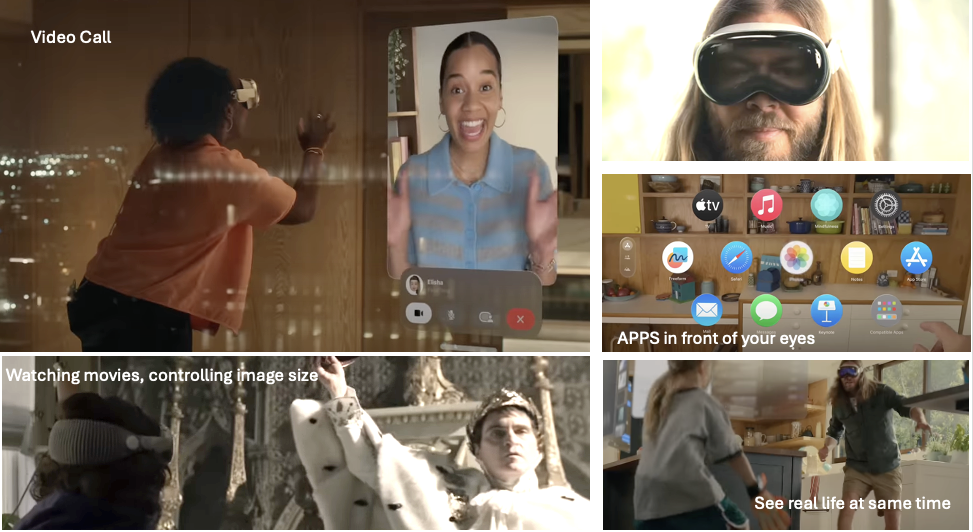
4. Competitive intensity
Apple is up against fierce competition in the VR headset market. Mark Zuckerberg’s Meta are the market leaders, with a 37% unit share in Q1 of 2024 compared to 17% for Apple in their launch quarter (though Apple’s value share in Q1 was an impressive 50%, given its huge selling price). Apple’s unit share for the full year is estimated at c. 6%.
We might expect Zukerberg to fight to protect Meta’s share given the estimated $30billion invested to date on the metaverse via the Reality Labs division. On the plus side for Apple, maybe the huge losses to date (see below) will mean Zukerberg decides to let Apple take the lead.
Competitive intensity score (higher score = less competition): 6/10
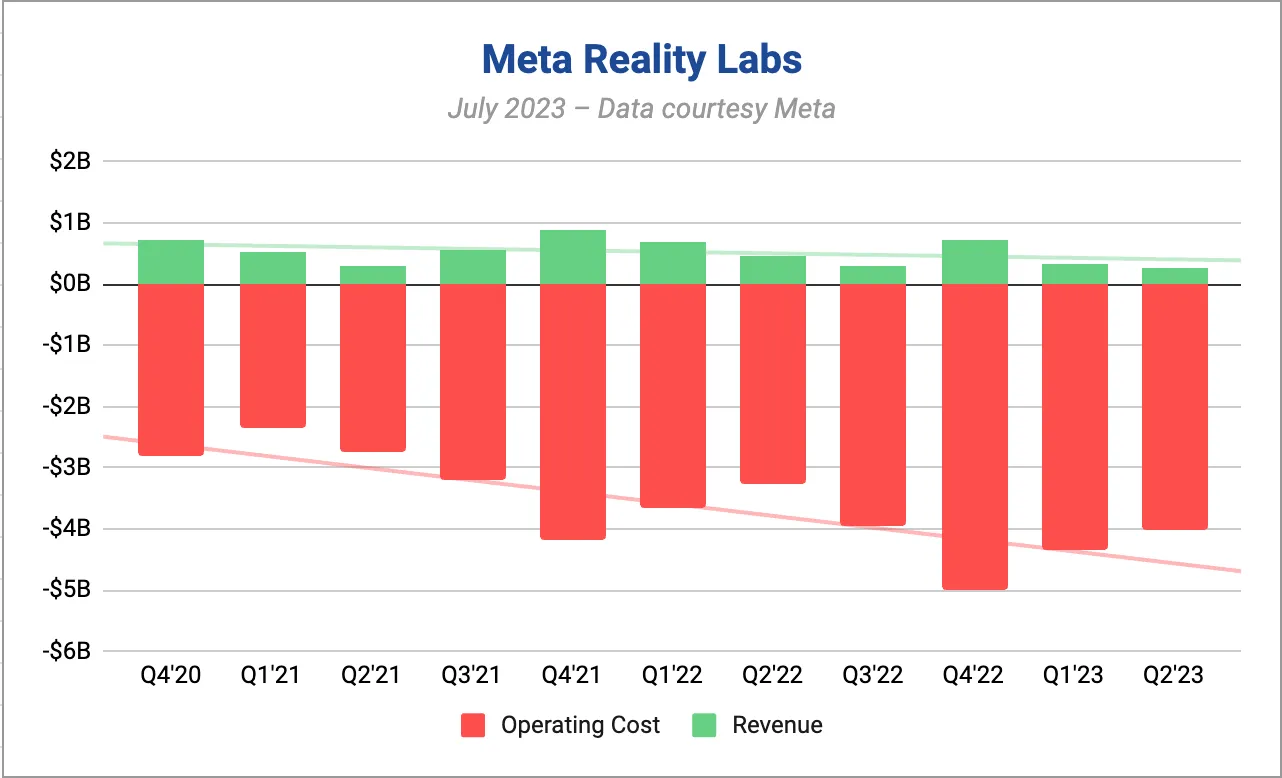
5. Underwhelming early results
“The overall trajectory of the Vision Pro’s launch this year has been a lot slower than many hoped for,” is how market tracker Omdia’s described early results from the launch in an FT article (5) . Unit sales in the first quarter of launch were 100,000, with Omdia predicting total year one sales of 350,000 Vision Pros, increasing to 750,000 in year two (2025) and 1.7mn in year three (2026). To put this into perspective, the year one sales of the iPad were 55 times bigger (6).
As with the market size predictions mentioned earlier, estimated sales for Apple’s Vision Pro were wildly over-optimistic. Goldman Sachs take the prize for the craziest call, suggesting that year one sales “could reach as many as 5mn shipments in 2024,” according to the FT (7)!
On the plus side, the Vision Pro does have a massive price tag, as mentioned earlier. Year one estimated revenue of $350million would be a huge business for any normal company, although small for a business with Apple’s scale (c. 1/8 of iPad’s year one revenue). Looking forward and using Omdia’s shipment forecast, Vision Pro could grow into a c. $6billion business (assuming selling price maintained at $3,500). Again, this looks huge, but is small compared to the annual revenue from AirPods (c. $10billion) and Apple Watch (c.$14-18 billion) estimated by Business of Apps (8).
Early results: 5/10
Total score: 22/50
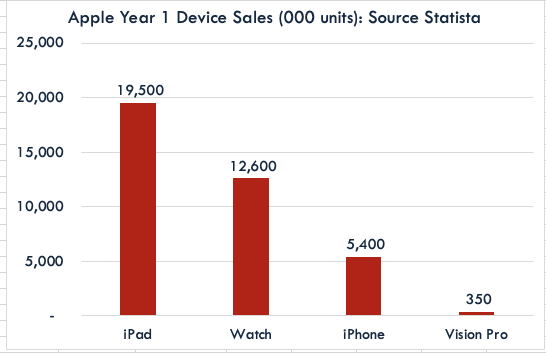
In conclusion, early results suggest that the Apple Vision Pro could become a multi-billion dollar business, but one that is small in the big scheme of things for Apple. Is all the R&D and marketing effort really worth it, if the business does end up being 1/2 the size of the AirPods business after three years? Probably not, meaning the Vision Pro would be a “miss”.
On the other hand, it is very early days. There is talk of a cheaper headset, which analysts predict could be launched “in the next year or two,” according to the FT (5). This could make Apple’s headset offer more mainstream, although even then I’m unsure the benefits are big enough to make a step-change in sales. In fact, the biggest users of VR and AR headsets like Apple’s Vision Pro could actually end up being business users, not consumers. Indeed, a lot of Meta’s advertising for the Quest is now focused on B2B applications.
The caveat for all the above analysis is, of course, that I do really need to try the product for myself. I do have an important birthday coming up, so maybe the Vision Pro needs to go on my wishlist for presents …. !
SOURCES
(1) Times Article inc Vision Pro reaction
(3) Taylor Swift tour revenue estimate
(4) Apple iPhone price premium
(5) FT article on Vision Pro UK launch
(6) Year 1 sales for Apple devices
